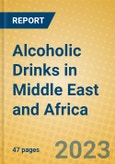The Alcoholic Drinks in Middle East and Africa global briefing offers an insight into to the size and shape of the Alcoholic Drinks market in both the off-trade and the on-trade, it highlights buzz topics, emerging geographies, categories and trends as well as pressing industry issues and white spaces. It identifies the leading companies and brands by total volume, offers strategic analysis of key factors influencing the market - be they new product developments, packaging innovations, economic/lifestyle influences, distribution or pricing issues. Forecasts illustrate how the market is set to change and criteria for success.
Product coverage: Beer, Cider/Perry, RTDs, Spirits, Wine.
Data coverage: Market sizes (historic and forecasts), company shares, brand shares and distribution data.
Why buy this report?
- Get a detailed picture of the Alcoholic Drinks market;
- Pinpoint growth sectors and identify factors driving change;
- Understand the competitive environment, the market’s major players and leading brands;
- Use five-year forecasts to assess how the market is predicted to develop.
Table of Contents
- Introduction
- Regional overview
- Leading companies and brands
- Forecast projections
- Country snapshots








